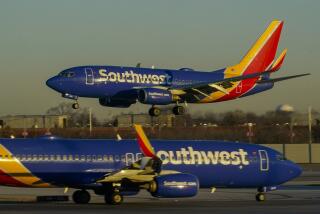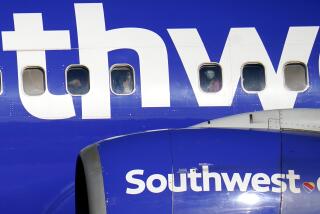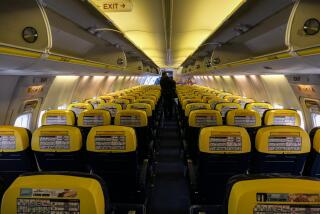COLUMN ONE : Making Air Travel Safe for Baby : Pressure is mounting to make infant safety seats mandatory on jetliners. Airlines are eager to promote family travel but fear a revolt from parents.
The death of an infant in Julyâs airliner tragedy at Sioux City, Iowa, has revived an emotional debate about the safety of the 9,000 babies who fly on U.S. airlines each day.
Though accidents are rare and most infants fly on laps without mishap, babies who do so are especially vulnerable in a crash. The force of gravity builds in a crash, turning a tiny child into an 100-pound weight, making it almost impossible for a motherâs arms to hold a child. The Federal Aviation Administration allows infants under 2 to sit on laps and fly free, but safety experts contend that infants who travel that way are not safe. âThere is no way to secure a child in your lap,â said Richard Chandler, who investigated crash survivability for the FAA for 18 years, and is now retired.
The final moments of United Airlinesâ ill-fated Flight 232 dramatically illustrate Chandlerâs contention.
As the crippled jet approached Sioux Cityâs airport, passenger Gayle Notgrass slipped a pillow under her babyâs head and covered him with a blanket. It was a poor cushion but the best she could do.
She put her sleeping 23-month-old son on the floor, as a flight attendant had instructed, and clutched his legs and chest.
Three rows ahead of Notgrass, Lori Michaelson struggled to keep 11-month-old Sabrina on the floor. It was hard to grip the baby, who was crying and trying to stand up.
Farther back in the plane, Sylvia Tsao wrapped her legs around 23-month-old Evan and tucked his head between her knees. Anxious to keep him close, she bent over and pushed her face down on his head.
A voice yelled, âBrace, brace!â and then, Tsao remembered, âthe world seemed to end.â The right wing of the doomed McDonnell Douglas DC-10 touched the ground, and the plane cartwheeled across farms near the airport, breaking apart.
Notgrass lost her grip on her baby; he flew from her hands and bounced against a wall like a tennis ball. Miraculously, she caught him. The Michaelson and Tsao infants sailed from their mothersâ arms like tiny missiles and disappeared into the smoke-filled plane.
Notgrass was able to get out of the plane with her baby. The Michaelson baby landed in an overhead bin and was rescued by a passenger who heard her cries. Tsao tried frantically to reach her baby, but another passenger guided her from the fiery wreck. The baby died, along with 111 other people.
In the wake of the Sioux City tragedy, the FAA faces pressure from consumers and Congress to make air travel safer for infants. The issue has taken on greater significance in light of new crash studies that show infants are at risk, and airline fare promotions that encourage families to fly.
Leading the drive for improved infant safety is the Los Angeles Area Child Passenger Safety Assn., which wants the FAA to require automobile safety seats for infants on aircraft. In June, the association petitioned the agency for a safety seat rule, triggering a legal process that forces the FAA to review its infant safety policy. Rep. Jim Lightfoot (R-Iowa) has threatened to introduce legislation to require the seats if the FAA fails to act.
Infant safety threatens to spark a debate within the Department of Transportation, which oversees the FAA. The FAAâs sister agency, the National Transportation Safety Board, has said it may recommend infant safety improvements to the FAA when the Sioux City crash investigation is complete. The NTSB has favored safety seats in the past.
Resistance by Parents
The FAA has not indicated how it will act. One FAA official who is actively involved in studying infant safety said she is not sure that parents want to use safety seats.
âThe public has indicated to us in the past that they want the option of not buying a ticket for a child under age 2,â FAA cabin safety specialist Donnell Pollard said. âThey like that freedom.â
Pollard said there is no doubt about what she would do. âIf I had a child, I would use a safety seat.â
A mandatory infant seat rule faces resistance from the airline industry, which favors voluntary use of safety seats. Airline executives are concerned that mandatory seats would put airlines in the rental business, since not all parents own automobile safety seats. The industry also fears a consumer revolt if parents are told they must buy tickets for infants who now fly free.
Janice Northcott, a safety expert for United Airlines, said the industry recognizes that infant safety needs improvement, but the problem is a tricky one. âWe are not moving slowly for the sake of being slow.â
Though rental car companies, such as Hertz and Avis, have provided infant safety seats for years, the airlines say it is more difficult for them to do so. Rental car companies are able to keep safety seats in stock because the cars, along with safety seats, are usually returned to the same location where they were picked up.
Safety a Sensitive Topic
Airline passengers presumably would be more likely to drop off a rented safety seat at their destination. This means airlines would have to haul safety seats back to the airports where demand is greatest.
Northcott was among the few airline executives willing to discuss infant safety, a sensitive topic because airlines depend on a safe image to sell tickets. Delta Air Lines, American Airlines, Pan America World Airways and Trans World Airlines declined to talk about safety seats. They referred questions to the Air Transport Assn., an industry group that is studying the issue.
The debate over infant safety is not new, but it has gained strength with a new study that shows the value of safety seats.
Just a month before the Sioux City disaster, an FAA crash test showed that baby-sized dummies strapped into automobile safety seats survived simulated air crashes. Baby dummies that sat on laps were crushed by their mothers.
The FAA tests support the findings of a 1981 Harvard University Medical School team. Using crash data from 1976 to 1979, the Harvard researchers found that infants traveling on laps were five times more likely to die in air crashes than adults using seat belts.
Automobile safety seats would have saved three of the five infants killed in so-called survivable air accidents during that period, the Harvard researchers said.
The Harvard report came in the wake of a 1978 United Airlines crash near Portland, Ore., that killed three children and drew attention to a need for infant restraints. In 1982, however, the FAA rejected a proposed rule requiring infant seats, saying that it would cost the airlines too much compared with the relatively few lives that would be saved.
Since 1985, the FAA has allowed automobile safety seats to be used on aircraft, but does not require them. The agency has left it up to the airlines to decide policy.
Safety advocates say the FAA is too permissive when it comes to infant safety. âThe government is implying by its behavior that there is no risk,â said Stephanie Tombrello, director of the Los Angeles Area Child Passenger Safety Assn.
The fact that infant safety seats are not required on airliners gives parents a false sense of security, she said. âMost people think that if the seats were necessary, they would be required,â she said.
Most safety experts agree that the special seats used for babies in cars provide the safest way for infants to travel. The safety seat holds the baby in place with a shoulder harness and a lap belt and is attached to the aircraft seat with a seat belt. FAA tests show that a safety seat can protect the baby in forces 16 times as powerful as gravity--more than an aircraft seat itself is built to withstand.
Crashes are not the only concern about infant passengers on airliners. Sudden and severe turbulence aloft is also a danger. When United Flight 90 slammed into a violent air pocket over Kansas in June, a 4-month-old infant was thrown from its motherâs arms into a coat rack. The babyâs neck was injured.
âAdult arms canât always handle a child,â said Unitedâs Northcott, who always uses a safety seat for her 1-year-old during plane trips. âAnyone who says anything else is massaging what we already know.â
Lap babies are at risk because the increased forces of gravity experienced during a crash make an infant feel heavier and harder to hold. Retired FAA accident investigator Chandler said that even moderate turbulence--the sort that upsets food trays--can loosen a motherâs grip on her child. The force in moderate turbulence, he said, is similar to dropping 115 feet--child in arms--on the Magic Mountain amusement parkâs high-speed Colossus roller coaster.
It is even trickier to hold a baby in a rough landing, when the increased force of gravity can instantly transform a tiny, 20-pound infant into a 100-pound weight. âImagine that someone dropped a 100-pound sack of flour in your lap,â Chandler said. âCould you catch it?â
Though Flight 232 passenger Notgrass, of Pine Bluff, Wyo., was able to catch her baby, the other two mothers traveling on the plane with infants were not.
âInfantsâ, toddlersâ and young childrenâs safety should no longer be ignored as if they do not count,â Tsao, of Albuquerque, later told federal investigators. âIf these kids need aircraft safety seats, then parents must be warned that they should put kids in them!â
Major airlines say they permit safety seats approved by the FAA, but their policies are not widely known--even by airline employees. When The Times called reservation agents for 13 U.S. airlines, most agents had to look up the policy or ask a supervisor. Some gave incorrect information.
âItâs up to the gate agent,â said a reservation clerk for Continental Airlines, when asked if car seats are allowed. âSome gate agents accept them and some donât.â
No Clear Seat Policy
An Eastern Airlines reservation agent said incorrectly that the seats are allowed on airliners only if they can be folded up, but she discouraged their use. âWhy would you want to do that? You can carry the baby on your lap for free.â
A United Airlines reservation clerk, when questioned, wrongly advised: âThey banned car seats. You have to put them in with check-in baggage.â
Los Angeles safety advocate Cheryl Kim said some parents are told by airline workers to store car seats in overhead bins. Other parents report that they have been allowed to use car seats for their infants--but not during takeoffs and landings, the most hazardous parts of a trip.
Bakersfield mother Carolyn Sherman paid $398 for an extra round-trip ticket to assure her 16-month-old daughter a seat on a flight to New York in August. Even so, airline workers told her to check her safety seat with her other baggage.
âWhen you tell them you bought a . . . (ticket for the baby), they are incredulous. They donât believe you.â Sherman eventually was allowed to use the car seat, but that did not end the hassle. Flight attendants later refused to bring baby Courtney a meal. âI had to show her ticket to everyone, again and again,â Sherman recalled in a recent interview.
âI felt like I was trying to transport heroin,â said Tombrelloâs sister, Vanessa Merton, who took her 2-year-old son with her on a European trip last spring. Merton said a Pan Am ticket agent would not let her use a car seat for her son until she put up a fuss. âItâs only people who make pests out of themselves that get to use the seats.â
The Air Transport Assn. recently endorsed voluntary use of safety seats, saying: âInfants and children are much safer in an approved restraint.â But the industry says mandatory safety seats pose big problems. Northcott said airlines feel pressure to provide the seats, since many parents--especially foreign travelers on connecting flights--do not have them.
Northcott said airlines might also have to supply the seats to assure that they are in good condition. She said some parents might be satisfied to have their infants use a broken or worn safety seat in the family car but that a damaged seat would not be acceptable to the airlines.
Headache for Airlines
Providing the seats would create a tremendous logistical headache for airlines. âHow many seats should we keep in which cities, and where should we store them?â asked Northwest Airlines safety expert Carol J. Grewing. âShould we charge a fee for their use? Should we require parents to make a reservation for the safety seat? It is a major complication for the airlines to address.â
It would also cause airlines to take a close look at air fares. The airlines are loath to give away seats, but they do not want to prevent families from flying. Industry executives interviewed said airlines might have to consider a new special fare for infants if safety seats become mandatory.
Airline executives say the expense of an extra ticket is one reason why few parents use the safety seats.
âI think many parents hesitate because of the extra cost,â Grewing said. She recalled that she had recently advised a neighbor to put her 1-year-old child in a car seat during a flight but had met with resistance. âShe wrinkled her nose and said she didnât want to pay for the babyâs seat.â
Car seats have other drawbacks, Grewing said. The seats are bulky and heavy--âhard for parents to lug around an airport, along with a baby and other luggage.â
The Air Transport Assn. has asked the FAA to come up with a car seat that is lightweight and easier to handle. The industry also wants a narrower seat that could be slid more easily into compact airline seats. Some car seats are so bulky that they block aisles.
But safety advocates say that the FAA should not wait until engineers come up with a better seat. âThe youngest and most dependent of us are the least provided for,â said Sioux City social worker Jerry Eaton, who became a safety activist after he counseled the Tsao family.
âFlotation devices, oxygen masks, seat belts--they are all designed for adults,â Eaton added. âThere is nothing for children.â
More to Read
Inside the business of entertainment
The Wide Shot brings you news, analysis and insights on everything from streaming wars to production â and what it all means for the future.
You may occasionally receive promotional content from the Los Angeles Times.








